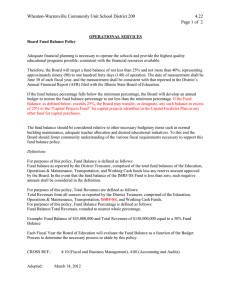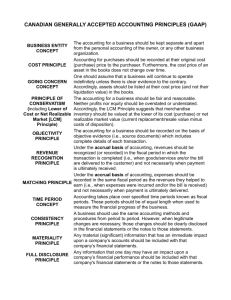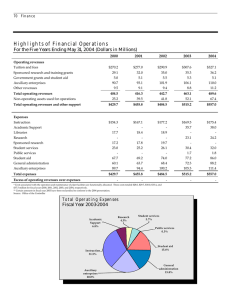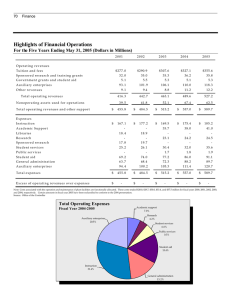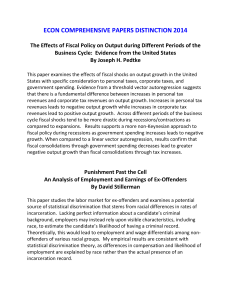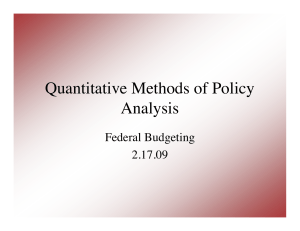GAO SEPTEMBER 11 Recent Estimates of Fiscal Impact of 2001
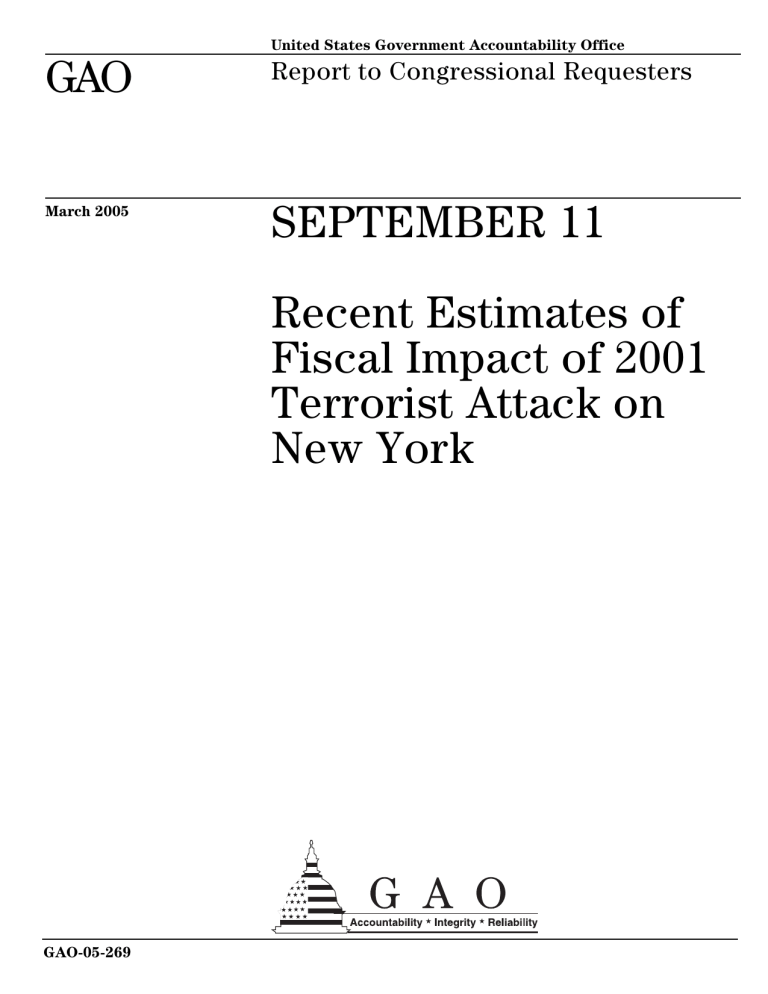
GAO
March 2005
United States Government Accountability Office
Report to Congressional Requesters
SEPTEMBER 11
Recent Estimates of
Fiscal Impact of 2001
Terrorist Attack on
New York
GAO-05-269
Accountability Integrity Reliability
H
ighlights
Highlights of GAO-05-269 , a report to congressional requesters
March 2005
SEPTEMBER 11
Recent Estimates of Fiscal Impact of 2001
Terrorist Attack on New York
Why GAO Did This Study
In 2002, GAO reported that the
New York budget offices estimated that from the terrorist attack, New
York City sustained tax revenue losses of $1.6 billion for 2002 and
$1.4 billion for 2003, New York
State $1.6 billion for 2002 and $4.2 billion for 2003. GAO found some limitations to these estimates, such as that it is likely that they included some of the economic recession under way in September 2001, as well as events after the attack, such as economic fallout from the Enron collapse and accounting firm improprieties.
After GAO issued its report in 2002, some New York agencies used revised economic data to assess the attack’s fiscal impact. In this context, GAO was asked to update its report to ascertain whether the recent government studies using revised economic data would provide more precise information on the fiscal impact of the terrorist attack. In doing this work, GAO did not independently estimate the attack’s impact on New York tax revenues.
What GAO Recommends
GAO makes no recommendations in this report.
In commenting on a draft of this report, the three New York agencies generally agreed with the information presented. In addition, two of the three agencies provided technical comments, which GAO incorporated, as appropriate. www.gao.gov/cgi-bin/getrpt?GAO-05-269 .
To view the full product, including the scope and methodology, click on the link above.
For more information, contact
Nancy R. Kingsbury at (202) 512-2700 or kingsburyn@gao.gov.
What GAO Found
Three recent studies by New York government agencies concluded that the 2001 terrorist attack on the World Trade Center significantly reduced tax revenues in fiscal years 2002 and 2003. But their estimates of forgone tax revenues—$2.5 billion to $2.9 billion for New York City and about $2.9 billion for New York
State—are generally less than previous estimates of forgone tax revenues. For example, the study completed in 2004 found, from revised economic data, that the economic recession that began before the attack generally had a greater impact on reducing New York tax revenues than initially projected. The studies completed in 2002 and 2003 were issued before subsequent revisions to employment data were released.
While the revised economic data indicate that New York’s economy was generally weaker before the attack than initially expected, inherent uncertainties and data limitations still prevent the estimates from being precise. The differences in the recent estimates reflect the uncertainties, the timing of the studies, and data limitations. As GAO reported previously, precisely measuring the attack’s effect on economic activity and tax revenues is inherently difficult, because it must be disentangled from other factors that also reduced tax revenues. In addition, a consensus has not yet emerged on employment and income impacts, key factors in measuring the attack’s impact on New York tax revenues.
Previous estimate of impact
City Office of
Management and
Budget
2002
$1,600
2003
$1,400
Total
$3,000 n.a.
n.a.
n.a.
City Comptroller
State Comptroller n.a.
n.a.
n.a.
State Division of Budget 1,600 4,200 5,800
Recent estimate of impact
2002 2003 Total
$926 $1,569 $2,495
910–
2,015
928
725 2,175 n.a.
n.a.
1,838–
2,943
2,900 n.a.
Source: New York City Office of Management and Budget (2004), New York City Office of the Comptroller (2002), New York State
Office of the State Comptroller (2003), and New York State Division of Budget (2002).
Note: Dollars in millions, unadjusted for inflation; n.a. is not applicable.
While the attack’s fiscal impact on New York from 2002 through 2003 appears to be less severe than initially expected, ascertaining its long-term impact is difficult, because other events also affected New York’s economy and tax revenues. For example, the New York City Office of Management and Budget projected more than $400 million in tax revenues forgone for 2004 and 2005, derived mostly because of estimates of securities jobs lost as a result of the attack. Even so, the extent to which securities jobs are fewer in New York City than if the attack had not happened is not clear. Other factors, such as the relatively high cost of conducting business have also affected securities employment in the city. The city’s property tax revenues will be lower than had there been no attack, however, because destroyed and damaged buildings have not been reconstructed.
United States Government Accountability Office
Contents
Letter
1
Results in Brief
Less Than Previously Estimated
The Long-Term Fiscal Impact May Depend on Factors Like
2
Background 3
Recent Assessments of Attack: Fiscal Impact Was Substantial but
9
Reconstruction 13
Agency Comments 17
Appendix I Objectives, Scope, and Methodology
18
Appendix II GAO Contacts and Acknowledgments
20
GAO Contacts 20
Acknowledgments 20
Table
Table 1: New York Agencies’ Estimates of the 2001 Terrorist
Attack’s Impact on New York City and State Tax
Revenues, Fiscal Years 2002–03 9
Figures
Figure 1: The Beginning of the Decline in Total Private Sector Job
Growth in Late 2000
Figure 2: New York City’s Greater Fall in Employment in 4 Months
Following the Attack Than in Prior Year
Figure 3: The Substantial Fall in New York City Jobs in Some
Industry Sectors in 4 Months Following the Attack,
Compared to Prior Year
Figure 4: The Start of the Fall in Total Private Sector Quarterly
4
5
6
Income Growth in 2001
Figure 5: New Jersey’s 2001 Temporary Increase in Securities
7
Employment 15
Figure 6: New York City’s Share of Total U.S. Securities
Employment 16
Page i GAO-05-269 Fiscal Impact of 2001 Terrorist Attack
This is a work of the U.S. government and is not subject to copyright protection in the
United States. It may be reproduced and distributed in its entirety without further permission from GAO. However, because this work may contain copyrighted images or other material, permission from the copyright holder may be necessary if you wish to reproduce this material separately.
Page ii GAO-05-269 Fiscal Impact of 2001 Terrorist Attack
United States Government Accountability Office
Washington, DC 20548
March 30, 2005
The Honorable Charles B. Rangel
Ranking Minority Member
Committee on Ways and Means
House of Representatives
The Honorable Carolyn B. Maloney
The Honorable Jos
é
E. Serrano
House of Representatives
New York’s economy improved significantly in 2004, after declining in the previous 3 years. Recent gains in overall employment, tax revenues higher than expected, and increased tourism may indicate that New York is rebounding from the economic recession that began in early 2001 and from the devastation of the September 11, 2001, terrorist attack.
Nonetheless, because New York’s economic growth has generally lagged behind that of the United States since the attack, questions remain about the extent to which the losses in jobs and tax revenue New York sustained were caused by the attack or by other factors, such as the recession.
In 2002, we reported that the New York budget offices estimated that for
2002 and 2003 combined, the impact of the terrorist attack would be about
$3.0 billion for New York City and $5.8 billion for New York State.
1 The estimates were based on economic forecasts that indicated tax revenues would likely be much lower than expected because of job and income losses brought about by the attack. But we found that the attack’s impact on tax revenues in 2003 was uncertain because it depended on factors that had not yet been determined, such as the degree to which the attack made
New York City less attractive for business.
Since we issued our report in 2002, some New York agencies have used revised economic data to assess the attack’s fiscal impact. Consequently, you asked us to update our report to ascertain whether the revised economic data provide more precise information. Accordingly, we
1
GAO, Review of the Estimates for the Impact of the September 11, 2001, Terrorist
Attacks on New York Tax Revenues , GAO-02-882R (Washington, D.C.: July 26, 2002).
Page 1 GAO-05-269 Fiscal Impact of 2001 Terrorist Attack
Results in Brief
reviewed the conclusions of recent government studies on the impact of the September 11 terrorist attack on New York tax revenues.
To identify government studies of impacts on New York tax revenues completed since our 2002 report, we reviewed the economics literature and searched the Internet, and we contacted officials at the U.S. Bureau of
Labor Statistics (BLS), Federal Reserve Bank of New York, New York City
Office of Management and Budget, New York State Division of Budget, and other state and local agencies. We identified studies completed by the
(1) New York City Office of Management and Budget in 2004, (2) New
York State Office of the State Comptroller in 2003, and (3) New York City
Office of the Comptroller in 2002. To review the studies, we used standard economic criteria, such as whether the studies measured the incremental effect of the attacks, used sound economic reasoning, and were based on current data. We discussed the impact of the attack with officials in the
New York City Office of Management and Budget, New York State Office of the State Comptroller, and New York City Office of the Comptroller, as well as with officials at BLS, the Federal Reserve Bank of New York, New
York City Independent Budget Office, New York State Division of Budget,
New York State Financial Control Board, and the Securities Industry
Association. We also discussed these issues with economics staff of the
New York State Assembly Ways and Means Committee. In doing this work, we did not independently estimate the impact of the terrorist attack on
New York tax revenues.
Unless we note otherwise, we determined that the data were sufficiently reliable for purposes of this report (app. I has more detail). We conducted our work from July 2004 through March 2005 in accordance with generally accepted government auditing standards.
Three recent studies by New York government agencies concluded that the terrorist attack on the World Trade Center significantly reduced tax revenues in fiscal years 2002 through 2003. But their estimates of the forgone tax revenues—$2.5 billion to $2.9 billion for New York City and about $2.9 billion for New York State—are generally less than the estimates of the forgone tax revenues that were estimated in 2002. For example, the most recent study, completed in 2004, found from revised economic data that the economic recession generally had a greater impact on reducing New York tax revenues than initially projected. The studies completed in 2002 and 2003 were completed before final revisions to the employment data were released.
Page 2 GAO-05-269 Fiscal Impact of 2001 Terrorist Attack
Background
While the revised economic data indicate that New York’s economy was weaker before the attack than initially expected, the inherent uncertainties and data limitations still prevent the estimates from being precise. As we reported previously, precisely measuring the effect of the terrorist attack on economic activity and tax revenues is inherently difficult because it must be disentangled from the effect of other events that also reduced tax revenues, such as the economic recession in 2001. In addition, a consensus has not yet emerged on the extent of the attack’s effect on employment and income, key factors in measuring New York tax revenues.
Although the short-term fiscal impact of the attack on New York appears to be less severe than initially projected, its long-term impact is difficult to ascertain because other events also affected New York’s economy and tax revenues. For example, the New York City Office of Management and
Budget also projected that the city will forgo $400 million annually in personal income tax revenues in 2004 and 2005, mostly derived from the loss of an estimated 17,000 securities jobs. However, the extent to which
New York City continues to lose jobs as a result of the attack is not clear, because factors such as the relatively high cost of conducting business have also affected securities employment in the city. Nonetheless, property tax revenues will continue to be lower than if there had been no attack, until the destroyed and damaged buildings are reconstructed.
The three New York agencies generally agreed with the information presented. Two also provided technical comments that we incorporated, as appropriate.
The September 11 terrorist attack on the World Trade Center killed nearly
3,000 people and destroyed and damaged a dozen buildings containing millions of square feet of office space. It severely affected New York’s economy, already in a downturn from a national recession and the collapse of Internet companies and associated industries.
2 Job growth in the United States and New York, an important indicator of economic conditions, had begun to decline in late 2000, turning negative several months before (see fig. 1). For example, job growth, which had been slowing in New York City, declined in June 2001, compared with June
2000, and bottomed out in January 2002. But because some jobs moved to
2
According to the Business Cycle Dating Committee of the National Bureau of Economic
Research, the recession began in March 2001 and ended in November 2001.
Page 3 GAO-05-269 Fiscal Impact of 2001 Terrorist Attack
0
-2
-4 other parts of the state, and to states like New Jersey and Connecticut, the net impact on New York State and the nation was less than on the city.
Figure 1: The Beginning of the Decline in Total Private Sector Job Growth in Late 2000
6
Percent change from prior year
Start of decline in employment after period of growth
9/11
4
2
-6
1998 1999
Trough of decline in employment
2000 2001 2002
Year and month
U.S.
N.Y.S.
N.Y.C.
2003 2004
Source: GAO analysis of Current Employment Statistics data from U.S. Bureau of Labor Statistics and New York State Department of
Labor.
Note: Includes revisions released in March 2005. Data for 2004 are subject to revision. Vertical line denotes September 2001.
Although job growth began to slow well before the attack, it declined noticeably in the 4 months after September 2001, particularly for New
York City. Employment growth in several major industry sectors fell more in the city than in the state or in the United States. The largest declines were in manufacturing and finance. In particular, employment in
Page 4 GAO-05-269 Fiscal Impact of 2001 Terrorist Attack
manufacturing declined by about 14 percent in New York City, compared with 9 percent in New York State and 8 percent in the nation. In addition, the financial sector grew about 1 percent in the United States but declined by about 9 percent in the city and about 6 percent in the state. Figure 2 illustrates these differences.
Figure 2: New York City’s Greater Fall in Employment in 4 Months Following the Attack Than in Prior Year
-16 -14 -12 -10
Percentage change from prior year
-8 -6 -4 -2 0 2
Manufacturing
Financial
Professional and business
Trade, transportaton, and utliities
Leisure and hospitality
Construction
Information
Other services
Natural resources and mining
Education and health
4 6
N.Y.C
N.Y.S.
U.S.
Source: GAO analysis of U.S. Bureau of Labor Statistics and New York State Department of Labor data.
Note: Employment categories are industry “supersectors,” as defined by the North American
Industrial Classification System. The change is measured from October 2001 through January 2002 relative to the same period in the prior year. January 2002 is the trough for New York total employment growth, as shown in figure 1.
Page 5 GAO-05-269 Fiscal Impact of 2001 Terrorist Attack
While some of these major sectors had significant job losses in New York
City year to year, losses in some subsectors were more substantial. For example, employment in the apparel sector of manufacturing declined 21 percent, and employment in air transportation—a component of the trade, transportation, and utilities sector—fell 19 percent from the same period the year before (fig. 3). In addition, within the financial sector, employment in the securities industry declined about 15 percent.
Decreased activity in these sectors from the combined effects of the recession and the attack contributed to these job losses. For example, a significant drop in demand for air travel in the attack’s aftermath is a major contributing factor in the decline in air transportation employment.
Figure 3: The Substantial Fall in New York City Jobs in Some Industry Sectors in 4 Months Following the Attack, Compared to
Prior Year
-25 -20 -15 -10
Percentage change from prior year
-5 0
Trade, transportation, and utilities
Transportation and warehousing
Air transportation
Financial activities
Finance and insurance
Securities
Manufacturing
Nondurable
Nondurable/apparel
Source: GAO analysis of current employment statistics data from U.S. Bureau of
Labor Statistics and New York Department of Labor.
Note: Employment categories are industry sectors defined by the North American Industrial
Classification System. The change is measured as October 2001 through January 2002 from the same period in the prior year. January 2002 is the trough for New York total employment, in figure 1.
Manufacturing, as a sector, experienced significant declines but accounted for 5 percent of the employment in major categories for the city. Finance and transportation accounted for larger proportions of employment—15
Page 6 GAO-05-269 Fiscal Impact of 2001 Terrorist Attack
and 18 percent respectively. For these reasons, the declines in these sectors, while somewhat less than those in manufacturing, are particularly important for the city’s economic condition. As with employment, income growth had already slowed and had turned negative in New York City and in the state several months before the attack (see fig. 4).
Figure 4: The Start of the Fall in Total Private Sector Quarterly Income Growth in 2001
Percentage change from prior year
20
9/11
15
10
5
0
1998
(5)
(10)
(15)
(20)
1999 2000 2001 2002 2003 2004
U.S.
Year and quarter
N.Y.S.
N.Y.C.
Source: GAO analysis of Quarterly Census of Employment and Wages data from U.S. Bureau of Labor Statistics and New York State
Department of Labor.
Note: The change in private sector quarterly income is measured relative to the prior year. According to BLS, because of delays relating to the attack, some businesses may have underreported income in third quarter of 2001 and overreported in the fourth quarter. A BLS official said this would not affect the overall trend over the latter part of 2001.
Page 7 GAO-05-269 Fiscal Impact of 2001 Terrorist Attack
As discussed above, the securities sector was one of the hardest hit.
Although the decline in securities employment was not as great as in some other sectors, high wage rates for the sector meant a much larger decline in income. For example, securities income fell by 28 percent in the first quarter of 2002 from the same quarter the previous year.
Other hard-hit sectors were air transportation, –20 percent; information,
–14 percent; and professional and technical services, –14 percent.
The decline in income has important ramifications for the collection of state and city revenues. The city’s tax revenue comes from taxes on personal and business income and sales, property, and real estate transfers; state tax revenue comes from taxes on personal income, business income, and sales. In general, property tax receipts are relatively stable from year to year, while the other tax receipts vary with economic cycles. In particular, because the state’s share of total tax receipts derived from income tax is more than 50 percent, its total tax receipts can be negatively affected when the economy contracts. In addition, New York has a sizable share of relatively high-paying jobs in the securities industry.
As a result, economic contractions that affect Wall Street and deflate stock values can negatively affect both state and city tax receipts.
The New York budget offices estimated in 2002 that from the terrorist attack, New York City sustained tax revenue losses of $1.6 billion for 2002 and $1.4 billion for 2003, New York State $1.6 billion for 2002 and $4.2 billion for 2003. In our 2002 report, we found some limitations to these estimates, such as that it is likely that they included some of the economic recession that was under way in September 2001, as well as events after the attack, such as economic fallout from the Enron collapse and accounting firm improprieties.
3 Given these limitations, we concluded that the estimates for 2002 appeared to reasonably approximate the impact of the attack but that the estimates for 2003 were more uncertain because they depended on factors that had not yet been determined, such as the degree to which the attack made New York City less attractive to businesses.
3
GAO-02-882R .
Page 8 GAO-05-269 Fiscal Impact of 2001 Terrorist Attack
Recent Assessments of Attack: Fiscal
Impact Was
Substantial but Less
Than Previously
Estimated
Three studies completed by New York government agencies after our 2002 report concluded that the September 11 terrorist attack significantly reduced New York tax revenues in 2002 and 2003. Their estimates of fiscal impact, however, were generally less than the estimates made in the attack’s aftermath. For example, the New York City Office of Management and Budget estimated in 2004 that the attack reduced the city’s tax revenues by about $926 million in 2002 and $1,569 million in 2003, for a total revenue loss of about $2.5 billion (see table 1).
4 By comparison, the agency’s initial total estimate in 2002 had been about $3.0 billion. Agency officials said that revised data on economic growth, employment, and income indicated that some of the tax revenue losses they attributed initially to the attack were more likely to be attributable to the recession.
Table 1: New York Agencies’ Estimates of the 2001 Terrorist Attack’s Impact on New York City and State Tax Revenues,
Fiscal Years 2002–03
New York agency
City Office of Management and
Budget
City Comptroller
State Comptroller
State Division of Budget
Previous estimate a
2002 2003
$1,600 $1,400
Total
$3,000
Recent estimate
2002 2003
$926 $1,569 b b b
910–2,015 928 b b b
725 2,175 b b
1,600 4,200 5,800
Total
$2,495
1,838–2,943
2,900 b
Source: New York City Office of Management and Budget (2004), New York City Office of the Comptroller (2002), New York State
Office of the State Comptroller (2003), and New York State Division of Budget (2002).
Note: Dollars are in millions, unadjusted for inflation. Estimates by the City Office of Management and
Budget and the City Comptroller represent forgone revenues for New York City for fiscal year July through June. The estimates by the State Comptroller and the State Division of Budget represent forgone revenues for New York State for fiscal year April through March. a
Previous estimate as reviewed in GAO-02-882R .
b
Not applicable.
For example, the agency developed a baseline revenue forecast from its revenue forecasting models to reflect what the economy would have looked like in the absence of the attack. To estimate the attack’s fiscal impact, the agency compared the baseline forecast with actual tax revenues collected in 2002 and 2003, adjusted for tax policy changes made
4
New York City Office of Management and Budget, Impact of 9/11 on New York City Tax
Revenue (New York: September 15, 2004; rev. February 1, 2005).
Page 9 GAO-05-269 Fiscal Impact of 2001 Terrorist Attack
after September 11.
5 In its initial study in 2002, the agency assumed that employment in the baseline revenue forecast would remain flat for 2001 and would increase by 0.7 percent in 2002. In its study using revised data, the agency estimated that employment would have declined by about 0.2 percent in 2001 and 1.8 percent in 2002 had there been no attack. With the updated forecast, the agency estimated that as a result of the attack, about
64,000 jobs and $11 billion in income were lost through the end of fiscal year 2002—a total of about 91,500 jobs and $22 billion in earnings through the end of fiscal year 2003.
The 2002 study by the New York City Comptroller estimated that the terrorist attack reduced the city’s tax revenues by a range of about $910 million to $2 billion in 2002 and by about $928 million in 2003.
6 The agency used two methods to assess the attack’s impact on tax revenues for the
2002 fiscal year. For example, in deriving the lower estimate, the agency assumed that the economic recession in 2001 would be comparable with the 1990–92 recession, in terms of reducing the city’s tax revenues. The agency then attributed to the terrorist attack the difference between the projected fall in tax revenues from the 2001 recession and a forecast of the city’s total tax revenues for fiscal year 2002. In deriving its higher estimate, the agency compared an estimate of the effect of a slowdown in the city’s economic growth on tax revenues with actual tax revenues collected in
2002 and attributed the difference to the effect of the attack. In addition, on the basis of a preattack projection of job growth, the agency estimated that the city lost about 146,100 jobs through July 2002.
The agency’s estimates of forgone revenue for the 2-year period are within range of the city budget office’s revised estimate of $2.5 billion, but since the city comptroller published its estimates in 2002, subsequent revisions to employment and other economic data have become available. For example, each year, the New York State Department of Labor revises the monthly employment data for the preceding 2 years. In March 2003, the state labor department reported that the revised estimate of private sector employment in New York was lower, both before and after the attack, than indicated in the revisions reported in March 2002.
5
The city budget office adjusted actual tax collections for the $1.4 billion in tax increases enacted in 2003. But its study did not assess the extent to which the higher taxes might have reduced economic activity and tax revenues.
6
New York City Office of the Comptroller, One Year Later: The Fiscal Impact of 9/11 on
New York City (New York: September 4, 2002).
Page 10 GAO-05-269 Fiscal Impact of 2001 Terrorist Attack
Finally, the New York State Comptroller’s 2003 study concluded that the attack reduced the state’s tax revenues by about $725 million in 2002 and
$2,175 million in 2003, for a total of $2.9 billion.
7 This is roughly half of the
$5.8 billion loss in tax revenues that the New York State Division of
Budget estimated in its 2002 analysis.
8 According to the comptroller’s office, the recession caused more job losses in the months leading up to the attack than initially expected—New York State lost about 75,000 jobs before the attack and about 40,000 jobs in its immediate aftermath. In addition, the state comptroller concluded that corporate accounting scandals significantly reduced the state’s tax revenues after the attack because of reduced Wall Street profits and year-end bonuses. As a result, agency officials said, the bulk of the state’s tax revenue losses in the 2-year period were the result of the recession and other events unrelated to the attack. Because the report was issued in early 2003, it did not incorporate revisions to the employment data that were made in March 2003.
Nonetheless, agency officials stated that the revisions provide additional support for their view that the recession that was under way at the time of the attack was more severe than initially expected.
Although the recent estimates may be useful as general indicators of the relative magnitude of the attack’s impact, inherent uncertainties about projecting economic activity in the absence of the attack and data limitations prevent them from being precise indicators. The differences in the estimates reflect these uncertainties, the timing of the studies, and data limitations. Measuring the attack’s effect on economic activity and tax revenues precisely is inherently difficult, because this effect must be disentangled from the recession and other events. In addition, a consensus has not yet emerged on the attack’s effect on employment and income— key factors in New York tax revenues in its aftermath.
For example, in a related study in 2002, the Federal Reserve Bank of New
York used a statistical model to simulate the attack’s effect on
7
New York State Office of the State Comptroller, 2003 – 2004 Budget Analysis: Review of
Economic and Revenue Forecasts (Albany, N.Y.: March 2003).
8
In 2005, a New York State Division of Budget official told us that the agency had not reassessed the fiscal impact of the terrorist attack but that estimates from the agency’s
2002 study still appear to be reasonable. See GAO-02-882R for a discussion of that 2002 study.
Page 11 GAO-05-269 Fiscal Impact of 2001 Terrorist Attack
employment and earnings.
9 The study found that the attack’s effect on employment had largely run its course by mid-2002 and that it caused net earnings losses of about $3.6 billion to $6.4 billion by June 2002.
Specifically, the study estimated that employment was lower by about
(1) 38,000 to 46,000 jobs in October 2001, (2) 49,000 to 71,000 jobs in
February 2002, and (3) 28,000 to 55,000 jobs by June 2002. However, the report was completed before the subsequent revisions to employment data were available.
In addition, a 2004 study by BLS economists found that the attack had a significant impact on employment in New York City. For example, the study estimated that the city lost the equivalent of about 143,000 jobs each month for 3 months after the attack and about $2.8 billion in wages.
10 The authors stated that they believe their estimates were conservative but that they were unable to isolate the attack’s impact after January 2002 because of other factors that may have also reduced employment.
Finally, a 2005 report by staff for the New York State Assembly on the status of the economy in lower Manhattan stated that the city sustained substantial losses in employment and wages after the attack.
11 For example, the report found that private sector employment in Manhattan was lower by 134,547 jobs during the first year after the attack and 172,013 jobs during the 3 years after the attack. However, the report did not attempt to separate out the effect of the attack from other factors that also reduced employment.
9
Jason Bram, James Orr, and Carol Rapaport, “Measuring the Effects of the September 11
Attack on New York City,” Economic Policy Review (New York: Federal Reserve Bank of
New York, November 2002). This study did not estimate fiscal impacts.
10
Michael L. Dolfman and Solidelle F. Wasser, “9/11 and the New York City Economy: A
Borough-by-Borough Analysis,” Monthly Labor Review (Bureau of Labor Statistics) 127:6
(June 2004). This study did not estimate fiscal impacts.
11
New York State Assembly Ways and Means Committee Staff, New York State: The Lower
Manhattan Economy After September 11th (Albany, N.Y.: February 2005). The report also estimated that income taxes declined by more than $400 million in the ground zero area of the city in the 3 years after the attack. The report did not attempt to separate out the effect of the contribution of other factors to economic losses.
Page 12 GAO-05-269 Fiscal Impact of 2001 Terrorist Attack
The Long-Term Fiscal
Impact May Depend on Factors Like
Reconstruction
Although the short-term fiscal impact on New York appears to be less severe than initially expected, the long-term impact may depend on factors such as the pace of reconstructing destroyed and damaged buildings.
Separating the long-term impact on employment and businesses is also difficult because of factors such as New York City’s recovery from the recession and businesses deciding to remain there, despite associated risk.
For example, the New York City Office of Management and Budget estimates that the city will lose more than $150 million in annual tax payments in fiscal years 2004 and 2005, mostly from property damage and loss at the seven World Trade Center buildings. According to the agency, only one building is being reconstructed; designs for the other buildings are not yet final. As a result, the agency expects that most of the property tax revenues that would have been generated had the attack not happened will not begin again until after 2010.
The agency’s estimate of forgone revenues presumes that beginning in fiscal year 2002, the city would have received annual property tax payments of about $98 million from the leaseholder, based on the market value of the commercial office space.
12 The precise amount the city would have received in revenues in the absence of the attack is not clear.
Historically, the city received about $28 million annually in payments in lieu of taxes from the buildings’ owner—the Port Authority of New York and New Jersey. Before the attack, the Port Authority leased several of the buildings and the city submitted a property tax bill to the leaseholder for about $98 million. But agency officials said that the city never received these tax revenues because the leaseholder contested the tax bill. After the buildings were destroyed, beginning in 2003, the city received payments in lieu of taxes from the Port Authority of about $3 million, representing the value of the World Trade Center site before any improvements. In addition, according to a new agreement with the Port Authority, the agency said that the city will receive about $6 million in fiscal year 2005 and $13 million in subsequent years.
The New York City Office of Management and Budget projected that the city would also forgo more than $400 million annually in personal income
12
The property tax was based on the capitalization of net income of a market basket of similar buildings in lower Manhattan. After 2002, the property tax was projected to increase at the billable assessed value growth rate for commercial properties.
Page 13 GAO-05-269 Fiscal Impact of 2001 Terrorist Attack
tax revenues in 2004 and 2005, derived from the loss of an estimated
17,000 securities jobs. To develop this estimate, the agency used information on the proportion of securities jobs in lower Manhattan in
March 2001 and an estimate of the number of jobs remaining outside New
York City as a result of the attack, as of September 2003. Agency officials said that these jobs were relocated to New Jersey and Connecticut.
How much the attack continues to affect securities employment is not clear. It may induce some businesses to relocate some jobs to ensure the continuity of their business in the event of a future catastrophic event. But the city’s share of total U.S. securities employment has been falling, partly because of the relatively high cost of conducting business in the city. As a result, separating the attack’s effect from structural changes in the industry is difficult. Figure 5 shows that job growth in the securities industry declined in the city after the attack but gradually recovered. In contrast, securities employment growth in New Jersey spiked sharply, but only temporarily.
Page 14 GAO-05-269 Fiscal Impact of 2001 Terrorist Attack
Figure 5: New Jersey’s 2001 Temporary Increase in Securities Employment
40
Percent change from prior year
9/11
30
-10
-20
-30
1998
20
10
0
1999 2000 2001
Year and month
2002
N.J. securities Conn.securities
2003 2004
N.Y.C. securities
Source: GAO analysis of Current Employment Statistics data from U.S. Bureau of Labor Statistics and New York State Department of
Labor.
Note: Includes revisions released in March 2005. Data for 2004 are subject to revision. Vertical line denotes September 2001. Employment growth is in securities, commodity contracts, and other financial investments and related activities.
In addition, New York City’s share of U.S. total employment in securities fell sharply after the attack but then recovered and returned to a level near its long-term trend (see fig. 6). According to reports by the Federal
Reserve Bank of New York and the Securities Industry Association, the downward trend began well before the 2001 attack, because of relatively higher business costs in the city, and the recession and attack exacerbated the trend. An official with the budget office said that New York City’s
Page 15 GAO-05-269 Fiscal Impact of 2001 Terrorist Attack
competitive position has improved because of rising commercial rents and land use pressures in New Jersey. For example, according to the agency, commercial rents in Hudson County, New Jersey—the most common destination for securities jobs leaving New York City—were 97 percent of those downtown in 2004, compared with 73 percent in 1990.
Figure 6: New York City’s Share of Total U.S. Securities Employment
40
Percent
9/11
35
30
25
20
15
1990 1992 1994 1996 1998
Year and month
N.Y.C. securities as a percentage of U.S.
2000 2002
Trend of N.Y.C securities as a percentage of U.S.
2004
Source: GAO analysis of Current Employment Statistics data from U.S. Bureau of Labor Statistics and New York State Department of
Labor.
Note: Includes revisions released in March 2005. Data for 2004 are subject to revision. Vertical line denotes September 2001. Employment is in securities, commodity contracts, and other financial investments and related activities. The trend line was estimated using the share of New York City securities employment as the dependent variable and time as the independent variable.
Page 16 GAO-05-269 Fiscal Impact of 2001 Terrorist Attack
Agency Comments
Finally, federal assistance to the New York City area in response to the attack has included funding for initial response efforts and infrastructure restoration and improvement, compensation for disaster-related costs and losses, and Liberty Zone tax benefits and business attraction and retention programs. According to the New York City agencies, however, none of the federal assistance provided so far has been to directly compensate for the tax revenues estimated to have been lost as a result of the attack.
We provided the three New York agencies with a draft of this report for their review and comment. The New York City Deputy Director of the
Office of Management and Budget generally agreed with the report’s content. The New York City Deputy Comptroller for Budget commented that the report accurately described the information in that agency’s 2002 study. Both officials also provided technical comments, which we incorporated, as appropriate. The New York State Deputy Comptroller for the City of New York commented that the report accurately summarized the findings in that agency’s 2003 study. In addition, the official said that the attack had a serious impact on the city and state economies but that later events—such as corporate scandals and wars in Afghanistan and
Iraq—also had an impact, especially on financial markets, and that events such as these increase the difficulty of isolating the long-term impact of the terrorist attacks.
As agreed with your offices, unless you publicly announce this report’s contents earlier, we plan no further distribution of it until 30 days from its issue date. We will then send copies to interested congressional committees. We will also make copies available to others on request. In addition, the report will be available at no charge on GAO’s Web site at www.gao.gov.
If you have any questions about this report, please contact me at (202)
512-2700. Key contributors to this report are listed in appendix II.
Nancy R. Kingsbury, Managing Director
Applied Research and Methods
Page 17 GAO-05-269 Fiscal Impact of 2001 Terrorist Attack
Appendix I: Objectives, Scope, and
Appendix I: Objectives, Scope, and
Methodology
Congressional requesters asked us to review recent government studies’ conclusions about the impact of the September 11 terrorist attack on New
York tax revenues. To identify government studies of the impact on New
York tax revenues completed since our July 2002 report, we reviewed the economics literature and searched the Internet, and we interviewed officials at the U.S. Bureau of Labor Statistics (BLS), Federal Reserve
Bank of New York, New York City Office of Management and Budget, New
York State Division of Budget, and other state and local agencies. We identified studies of the fiscal impacts by the (1) New York City Office of
Management and Budget (2004), (2) New York State Office of the State
Comptroller (2003), and (3) New York City Office of the Comptroller
(2002). In addition, in our literature review, we identified related studies about the employment and income effects of the attack issued by BLS, the
Federal Reserve Bank of New York, and New York State Assembly Ways and Means Committee staff. To review the studies, we used standard economic criteria, such as whether the studies measured the incremental effect of the attacks, used sound economic reasoning, and were based on current data. In doing this work, we did not independently estimate the impact of the terrorist attack on New York tax revenues.
We discussed the attack’s impact on New York’s economy with senior officials of the three New York agencies, as well as officials at BLS, the
Federal Reserve Bank of New York, New York City Independent Budget
Office, New York State Division of Budget, New York State Financial
Control Board, Securities Industry Association, and TenantWise (a commercial real estate firm in New York) and economics staff of the New
York State Assembly Ways and Means Committee.
We took several steps to assess the validity and reliability of data underlying the estimates of the New York agencies that we discuss in this report. We reviewed the documentation, methods, and key assumptions underlying the agencies’ analyses, and the documentation and procedures underlying key inputs, such as the employment and income data from the
Current Employment Statistics and the Quarterly Census of Employment and Wages programs, which are administered cooperatively by BLS and the New York State Department of Labor. We also interviewed officials at
BLS and the New York State Department of Labor about their procedures for collecting and revising these data.
In addition, we reviewed revenue reports and financial statements prepared by the state and city and reviewed by independent auditors, and we discussed the validity and reliability of data on city and state tax revenues with officials at the New York City Independent Budget Office,
Page 18 GAO-05-269 Fiscal Impact of 2001 Terrorist Attack
Appendix I: Objectives, Scope, and
Methodology
New York City Office of the Comptroller, New York City Office of
Management and Budget, New York State Financial Control Board, and
New York State Office of the State Comptroller. We used data from
Current Employment Statistics and the Quarterly Census of Employment and Wages programs in the background and findings sections of this report. Unless we note otherwise, we determined that the data were sufficiently reliable for purposes of this report.
We conducted our work from July 2004 through March 2005 in accordance with generally accepted government auditing standards.
Page 19 GAO-05-269 Fiscal Impact of 2001 Terrorist Attack
Appendix II: GAO Contacts and
Appendix II: GAO Contacts and
Acknowledgments
GAO Contacts
Acknowledgments
Nancy R. Kingsbury (202) 512-2700, kingsburyn@gao.gov
Joseph D. Kile (202) 512-5684, kilej@gao.gov
In addition to the persons named above, Carol Bray, Tim Guinane,
Penny Pickett, Teresa Renner, and Anne Stevens made key contributions to this report.
(460569)
Page 20 GAO-05-269 Fiscal Impact of 2001 Terrorist Attack
GAO’s Mission
Obtaining Copies of
GAO Reports and
Testimony
Order by Mail or Phone
To Report Fraud,
Waste, and Abuse in
Federal Programs
Congressional
Relations
Public Affairs
The Government Accountability Office, the audit, evaluation and investigative arm of Congress, exists to support Congress in meeting its constitutional responsibilities and to help improve the performance and accountability of the federal government for the American people. GAO examines the use of public funds; evaluates federal programs and policies; and provides analyses, recommendations, and other assistance to help
Congress make informed oversight, policy, and funding decisions. GAO’s commitment to good government is reflected in its core values of accountability, integrity, and reliability.
The fastest and easiest way to obtain copies of GAO documents at no cost is through GAO’s Web site ( www.gao.gov
). Each weekday, GAO posts newly released reports, testimony, and correspondence on its Web site. To have GAO e-mail you a list of newly posted products every afternoon, go to www.gao.gov
and select “Subscribe to Updates.”
The first copy of each printed report is free. Additional copies are $2 each.
A check or money order should be made out to the Superintendent of
Documents. GAO also accepts VISA and Mastercard. Orders for 100 or more copies mailed to a single address are discounted 25 percent. Orders should be sent to:
U.S. Government Accountability Office
441 G Street NW, Room LM
Washington, D.C. 20548
To order by Phone: Voice: (202) 512-6000
TDD: (202) 512-2537
Fax: (202) 512-6061
Contact:
Web site: www.gao.gov/fraudnet/fraudnet.htm
E-mail: fraudnet@gao.gov
Automated answering system: (800) 424-5454 or (202) 512-7470
Gloria Jarmon, Managing Director, JarmonG@gao.gov
(202) 512-4400
U.S. Government Accountability Office, 441 G Street NW, Room 7125
Washington, D.C. 20548
Paul Anderson, Managing Director, AndersonP1@gao.gov
(202) 512-4800
U.S. Government Accountability Office, 441 G Street NW, Room 7149
Washington, D.C. 20548
PRINTED ON RECYCLED PAPER
